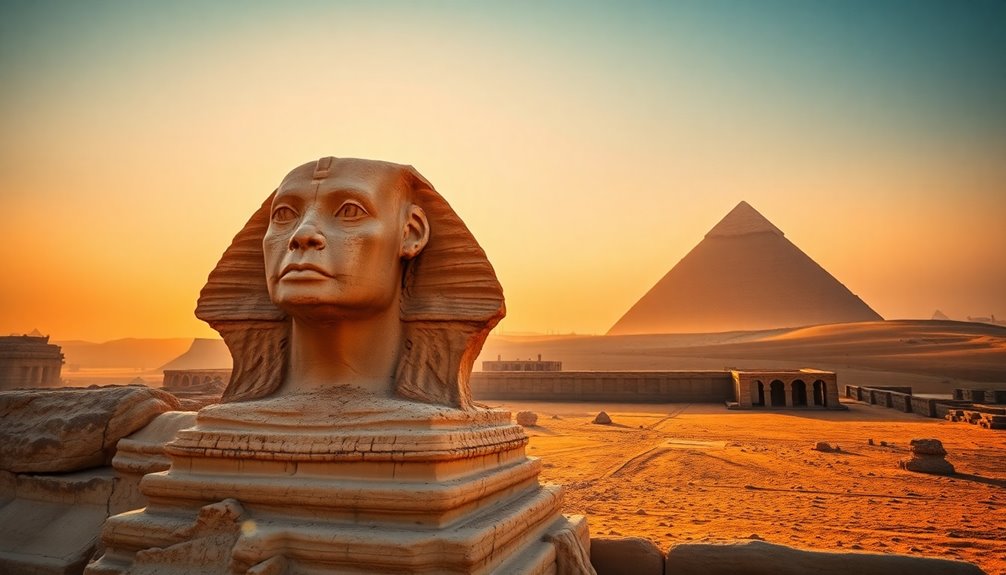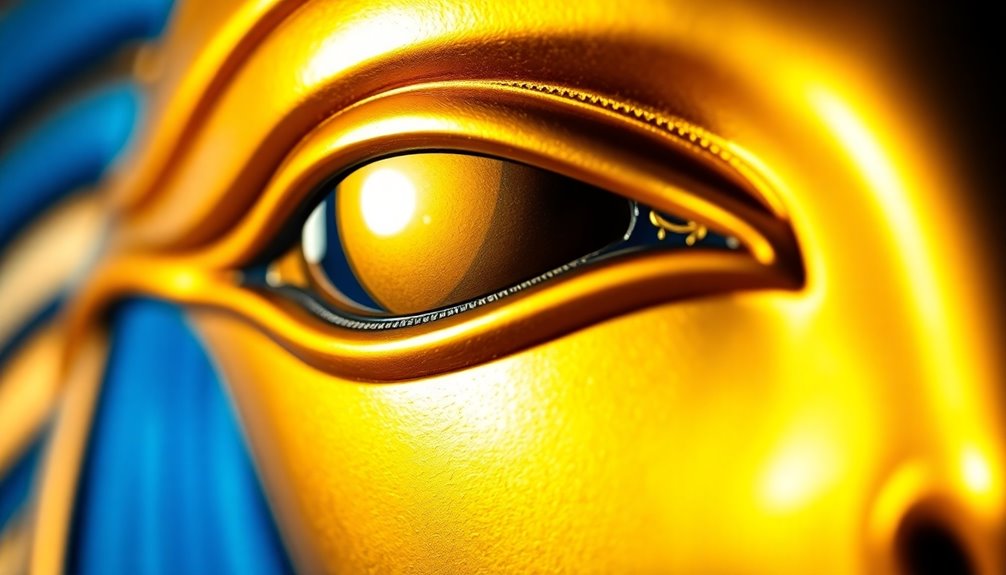The Great Sphinx of Giza was constructed around 2500 B.C. during Pharaoh Khafre's reign. Standing proud between the pyramids of Khufu and Khafre, it symbolizes the ancient Egyptian civilization's artistry and ambition. You may be surprised to learn that some theories suggest it could be even older, potentially predating Khafre by 9,000 years. Carved from limestone by approximately 100 skilled workers, its vibrant original colors have faded over time due to erosion. The Sphinx holds secrets that could reshape how you view ancient history, and there's so much more to uncover about this iconic landmark.
Key Takeaways
- The Great Sphinx of Giza was built around 2500 B.C. during the reign of Pharaoh Khafre.
- Some theories suggest the Sphinx may predate Khafre by up to 9,000 years.
- It was carved from a single limestone piece, showcasing advanced construction techniques.
- Historical records indicate the Sphinx's nose was missing before Napoleon's arrival, lost in the 14th century.
- Ongoing research continues to challenge traditional views on its origins and construction.
Historical Background of the Sphinx

When you look at the Great Sphinx of Giza, you're witnessing a marvel that dates back to around 2500 B.C., during Pharaoh Khafre's reign in the Fourth Dynasty. This monumental sculpture, located on the Giza plateau, stands strategically between the pyramids of Khufu and Khafre, hinting at a deep connection to these iconic structures.
Measuring approximately 240 feet in length and 66 feet in height, the Sphinx is one of the oldest and largest monumental sculptures in the world.
While it's commonly attributed to Pharaoh Khafre, the absence of direct inscriptions or historical records linking him definitively to the Sphinx opens the door to alternative theories. Some scholars suggest that the Sphinx may actually predate Khafre, arguing that geological evidence and erosion patterns indicate it could be as old as 9,000 years.
This debate about its origins adds a fascinating layer to our understanding of ancient Egypt's history. The Great Sphinx remains a symbol not just of Pharaoh Khafre's reign, but of the enduring mysteries that surround one of humanity's most significant achievements.
Construction Techniques and Labor
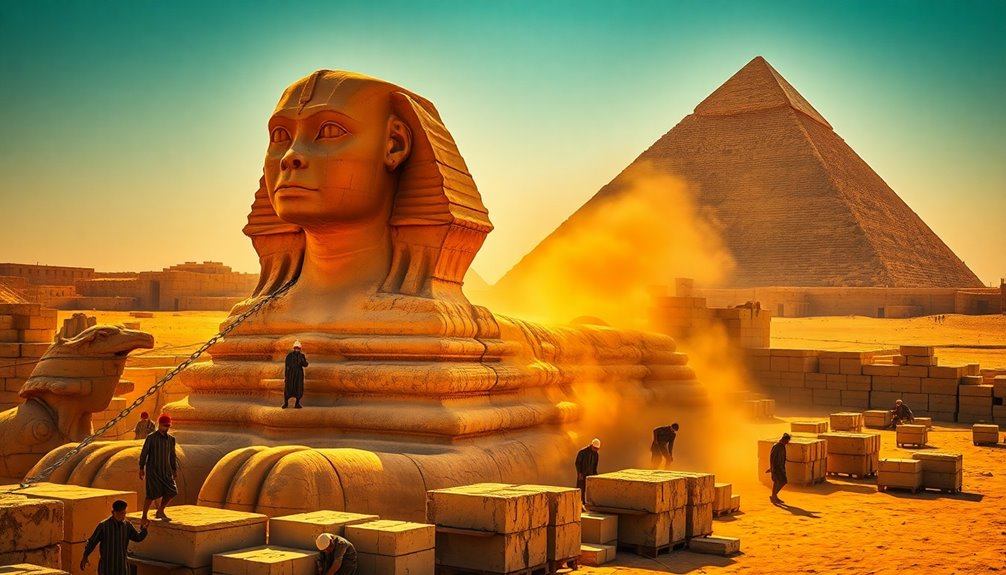
The construction of the Great Sphinx showcases the remarkable engineering skills and labor organization of ancient Egypt. Built around 2500 BC during the reign of Pharaoh Khafre, the Sphinx was carved from a single piece of limestone bedrock.
You'd be amazed to know that approximately 100 workers collaborated on this monumental project, utilizing tools like stone hammers and copper chisels.
These ancient builders employed advanced construction techniques that demonstrated their understanding of stonework and artistry. The completion of the Sphinx likely took about three years, reflecting both the labor involved and the artistic vision behind it.
Evidence of pigment residue shows that the Sphinx was originally adorned with vibrant colors, adding to its visual appeal.
As you consider the scale and complexity of this project, it's clear that the Sphinx represents not just a monumental statue but a reflection of the ingenuity and organized labor of its time.
The workers, under Pharaoh Khafre's direction, created an iconic structure that continues to captivate people even today. The construction techniques they used laid the groundwork for future monumental projects throughout ancient Egypt.
Cultural Significance and Myths
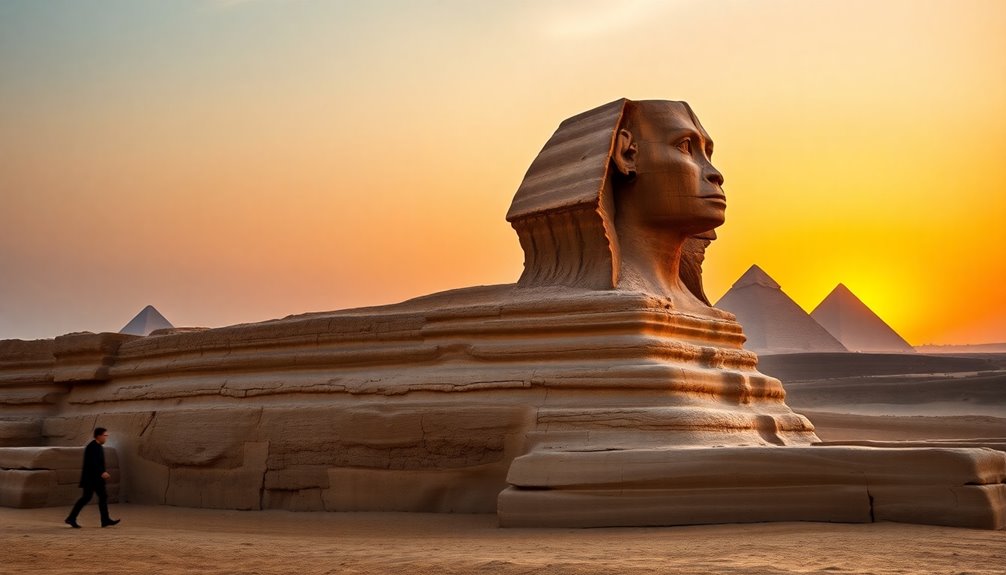
Steeped in mystery and majesty, the Great Sphinx of Giza stands as a powerful symbol of ancient Egypt, embodying its rich cultural heritage. This iconic structure represents not only architectural achievement but also serves as a guardian figure for the temple complexes surrounding it.
Ancient Egyptians believed the Sphinx was linked to the divine power of pharaohs and the solar deities, particularly Ra, highlighting its cultural significance in their society.
Myths surrounding the Sphinx extend beyond Egypt, influencing narratives across cultures. The connection to the riddle of the Sphinx from Greek mythology showcases its impact on storytelling and collective imagination.
During the 12th and 13th centuries, locals recognized the Sphinx's importance in their daily lives, making offerings to it with hopes of blessings for agricultural success.
Even today, the Sphinx's iconic status inspires countless replicas around the world, reinforcing its role as a cultural symbol that transcends borders.
As you explore its rich history, you'll uncover layers of meaning that continue to resonate with people across time and space, reflecting the enduring legacy of this extraordinary monument.
Erosion and Restoration Challenges

Over the centuries, the Great Sphinx has faced significant challenges from erosion, primarily due to environmental factors like wind and sand. This erosion has led to the ongoing degradation of the Sphinx, particularly on its softer limestone body, which wears away faster than the harder stone of its head.
Historical records reveal that the Sphinx's nose was missing long before Napoleon's arrival, being chiseled off in the late 14th century by Muhammad Saʾim al-Dahr, highlighting the impact of human activity on this ancient monument.
Significant restoration efforts began in the late 1930s under Egyptian archaeologist Selim Hassan, aiming to combat the Sphinx's deterioration. These restoration projects face ongoing challenges, as environmental factors continue to threaten its preservation.
Archaeological studies are essential in evaluating the current condition of the Sphinx, helping experts devise effective strategies for its maintenance.
As you explore the history and significance of the Sphinx, remember that its survival hinges on understanding these erosion and restoration challenges. The ongoing efforts to preserve this monumental piece of history are imperative, ensuring that future generations can appreciate its grandeur.
Modern Discoveries and Theories
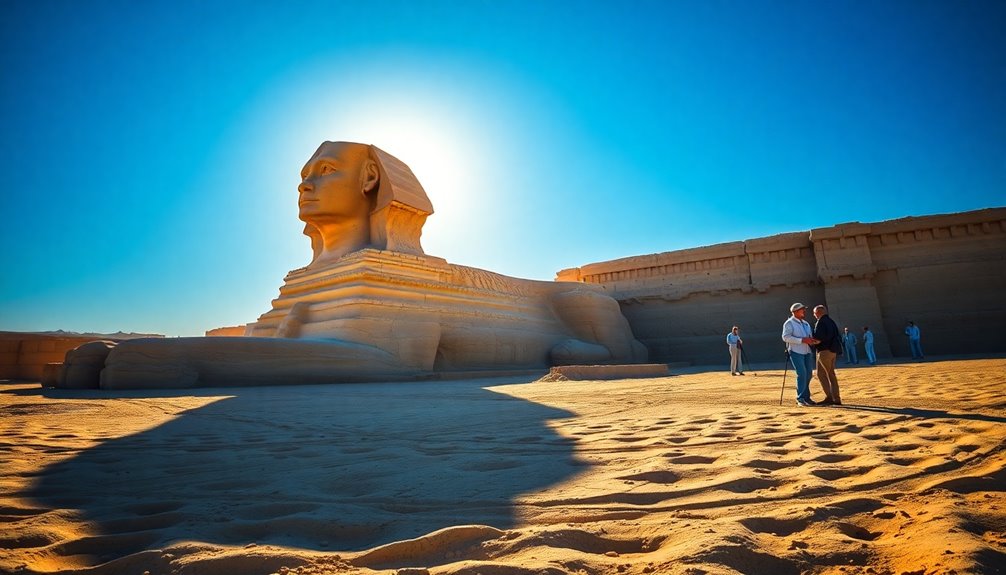
Recent archaeological advancements have shed new light on the history of the Great Sphinx, challenging long-held beliefs about its origins. While most scholars agree it was built around 2500 B.C. during the reign of Pharaoh Khafre, some modern discoveries suggest it could predate him considerably. Geological assessments indicate that the erosion patterns on the Sphinx might align with climatic conditions as far back as 7000 B.C., hinting at a much older origin.
Theories have emerged proposing that Khufu or his son Djedefre could be responsible for its construction, sparking ongoing debates due to the absence of direct inscriptions linking Khafre to this iconic monument.
Excavations have unearthed crucial evidence about the construction techniques used by ancient Egyptians, revealing their impressive engineering capabilities in monumental architecture.
As research continues, collaborative efforts are uncovering new findings that deepen our understanding of the Sphinx and its creators. These insights not only reshape our comprehension of the Great Sphinx itself but also reflect the broader context of ancient Egyptian society and its remarkable achievements in architecture and art.
Frequently Asked Questions
When Was the Sphinx Built and by Whom?
You might wonder about the origins of the Great Sphinx of Giza. Most experts believe it was built around 2540 B.C. during Pharaoh Khafre's reign.
Its impressive size—240 feet long and 66 feet high—makes it a monumental feat.
However, some scholars propose alternative builders, like Khufu or Khafre's brother, Redjedef.
The debate continues over its true age, with some suggesting it could date back to as early as 7000 B.C.
How and Why Has the Statue of the Sphinx Changed Since It Was Made?
Have you ever wondered how the Sphinx transformed over the centuries?
Originally vibrant with colors, it's now weathered and eroded. The nose, famously missing, was removed in the 14th century due to changing cultural beliefs.
Restoration efforts, both ancient and modern, aim to stabilize this iconic structure.
As its perception shifted from a guardian to a symbol of mystery, the Sphinx continues to captivate and influence how we interpret its enduring legacy.
Why Was the Great Sphinx of Giza Built Blowing up History?
You might wonder why the Great Sphinx of Giza was built. It served as a monumental guardian, embodying the strength and wisdom of ancient Egyptian culture.
Commissioned likely by Pharaoh Khafre, it reinforced his divine status and protected the sacred burial site. Its immense size and unique design captivated the ancient world, influencing future cultures.
The Sphinx's creation reflects deep religious beliefs, showcasing how monumental architecture shaped historical narratives and cultural identity.
Why Did Khafre Build the Sphinx?
You might wonder why Khafre built the Sphinx. He aimed to create a powerful symbol of protection for his pyramid complex, linking his reign to divine guardianship.
Positioned strategically between the pyramids, the Sphinx served to safeguard the pharaoh's tomb and reinforce his connection to the sun god Ra.
Its lion body and human head reflect Khafre's strength and wisdom, making it a focal point for rituals and offerings in ancient Egypt.
Conclusion
So, next time you gaze at the Sphinx, just remember: it's not just a giant cat statue that's been lounging around for millennia, but a perplexing puzzle wrapped in ancient mysteries. You've got ancient Egyptians, questionable construction techniques, and enough erosion to rival your grandma's face cream. And as modern theories pop up like weeds, you might wonder if the Sphinx is just a cosmic prank—an oversized riddle designed to keep historians scratching their heads for eternity!

